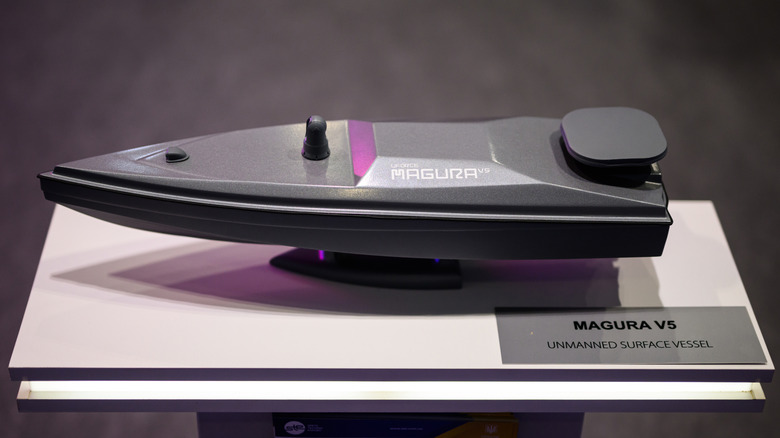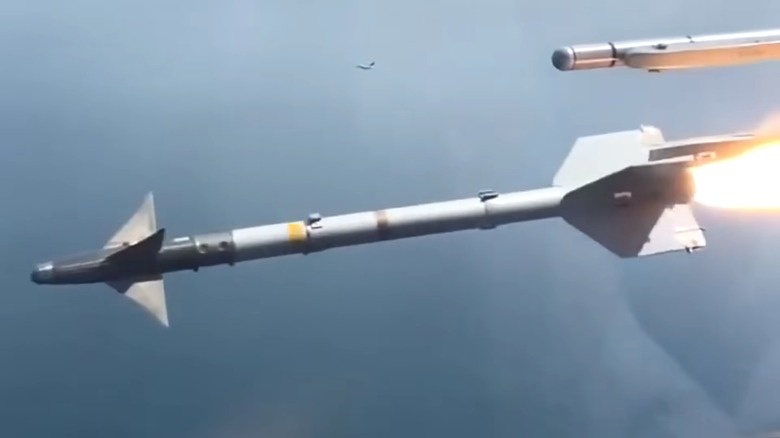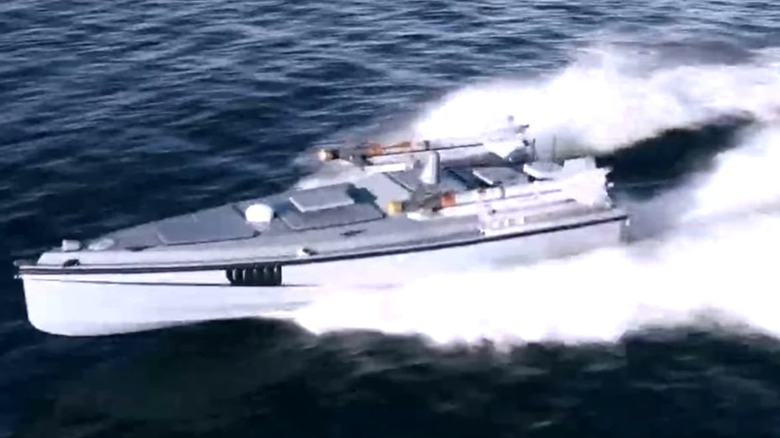What Supersonic Missile Is Ukraine Using To Take Down Russian Fighter Jets From Drone Boats?
The Russo-Ukraine War has pushed the defending nation to new heights in terms of offensive and defensive innovation. This has resulted in new ways of taking on an enemy in what can be described as a 'David and Goliath' situation. Ukraine, being the smaller of the two nations, has had to think outside the box in terms of taking on enemy threats, which has pushed drone development into previously unseen areas. Of particular note is Ukraine's use of high-tech tools like uncrewed surface vessels (USV), which are drones that operate on the water.
Ukraine's success with these watercraft has proven capable of taking out key infrastructure, and Russia's Black Sea Fleet is significantly degraded. Previous Ukrainian USVs worked by piloting them into targets and detonating, making them similar to kamikaze drones, which Ukraine has employed to great success in sinking Russian warships. Ukraine's latest innovation in the realm of USV development is its drone boats, which engage and shoot aircraft out of the sky. These improved USVs are agile floating missile platforms, and they're a game changer for the ongoing conflict.
Ukraine's Maritime Autonomous Guard Unmanned Robotic Apparatus V-type (MAGURA) V5 first engaged in combat operations against Russian surface vessels of the Black Sea Fleet in 2023 and evolved into its latest model, the V7, in 2025. The MAGURA V7 is designed specifically to strike enemy aircraft, and it has demonstrated this ability with deadly precision thanks to its ability to carry and fire two supersonic AIM-9M Sidewinder air-to-air missiles. These elevate the MAGURA's lethality to new heights, ensuring Russia cannot gain air superiority when its aircraft are targeted from the land, air, and sea.
The MAGURA V7 successfully shot two Su-30 Flankers out of the sky
The Sukhoi Su-30 Flanker Russian fighter jet is a premiere aviation asset, but two of them proved incapable of avoiding AIM-9M sidewinders fired at them by MADURA V7s in early 2025. The incident occurred on May 2, 2025, when a Ukrainian special operation unit, working with the Security Service of Ukraine and the Defense Forces of Ukraine, fired at and destroyed the two fighters over the Black Sea.
This incident is notable, as it's not only the first time a drone boat took out an aircraft, but it's also the first use of an AIM-9 from a USV that resulted in a kill. The Defense Intelligence of Ukraine posted a video of the successful engagement, and it shows the aircraft being targeted and destroyed by the USVs. Three of the boats were used in the attack, and two of them fired on the jets, though further details remain undisclosed. The crew from one of the jets was killed, while the others were rescued by a civilian ship on the Black Sea.
The AIM-9M Sidewinder used by Ukraine is a naval variant of the air-to-air missile, which has been in active service since 1956. The missiles are heat-seeking, employing an infrared homing system for guidance. Their range is between 10 and 18 miles, and they travel up to Mach 2.5 (1,918 mph), making them supersonic and difficult to defend against and avoid. Around 270 kills have been attributed to the AIM-9 Sidewinder, and now that Ukraine has successfully shot two Su-30 Flankers out of the sky, that number has increased.
The MAGURA V7 boasts incredible capabilities
The MAGURA V7 is designed to take out airborne targets, but it's not limited to that function. If required, the missile launch system can be swapped out for a machine gun, making it capable of engaging a variety of naval targets. Additionally, a machine gun-equipped MAGURA-V7 could accompany the missile launch platform version to provide cover while airborne targets are engaged. The gun is gyro-stabilized with day and night imaging, which is likely operated by an additional operator, not the same person who steers the boat itself.
In addition to firing the AIM-9M Sidewinder, the MAGURA V7 will be able to accommodate the R-37, which is a Soviet-era air-to-air missile with comparable capabilities. In addition to combat operations, the MAGURA V7's payload capacity of 1,433 pounds enables logistical cargo carrying tasks, firefighting operations, and maritime patrolling. Additionally, the V7 can carry acoustic monitoring equipment to detect submarines and other underwater threats. The vessel is operated via a multi-channel satellite communications system, which limits an adversary's ability to jam or interfere with its comms capabilities.
The vessel itself measures 23.6 feet in length and is constructed from a fiberglass hull. It's two tons heavier than the V5, weighing in at 7,496 pounds, which makes it somewhat slower than its predecessors. Despite this, it has a maximum speed of 45 mph on the water and can operate in rough conditions with waves cresting as high as 9.8 feet. The MAGURA V7's endurance is between two and seven days, and it has a range of 932 miles, making it versatile and capable of operating against Russian assets wherever it is deployed.


